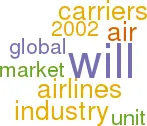Market outlook
January 2003


Times are tough for the mainstream aviation industry. IATA is now estimating a net loss of $13bn for the global industry in 2002. And the painfully slow recovery from September 11 has been overshadowed by the prospect of war in Iraq.
We have no particular insight into the potential Iraqi war, just a hope, shared by most people in the West, that it will not happen.
If it does happen, there will be a short–term surge in the spot price of crude oil and kerosine. However, as there is a global excess of supply over demand in the oil industry and a lack of solidarity within OPEC, the overall outlook is for a softening in fuel prices in 2003.
The bigger concern for the aviation sector is that confidence in air travel will again be undermined and the incipient recovery in the transatlantic market will be choked off. As well as the Middle Eastern carriers like Gulf Air, Emirates and Saudia, the Euro–majors are exposed to developments in the region. BA and KLM earn about 5–6% of their revenues on routes to/from the Middle East while for Lufthansa, Air France and Alitalia the proportion is 2–3%.
In terms of the global market balance, the supply side adjustments in terms of parking, downsizing, order deferrals and cancellations. The number of parked aircraft peaked at about 2,200 at mid–year and has remained at that level while aircraft available for sale or lease has declined slightly from its early 2002 peak of around 1,400.
Load factors are at record levels: 75.7% for the AEA carriers in the first nine months of last year, 70.7% for US domestic traffic and 76.7% for US international traffic. Yet yields have resolutely refused to rebound — for example, the average US domestic fare in November 2002 was 20% lower than that in November 2000 while the average international fare was 10% lower. KLM’s recent profit warning was announced at the same time as it was reporting the highest load factors for eight years.
What this means is that the mainline scheduled industry will not be rescued by unit revenue growth. Indeed, it is likely that business fares will continue to be reduced on both sides of the Atlantic as airlines attempt to recapture business travellers disillusioned by their treatment during the boom times of the late 90s.
Other ideas like airlines within airlines are being tried, on the basis that mistakes from previous failed attempts at this concept will not be repeated, and some mergers or takeovers are being considered, but without much enthusiasm. This unfortunately leaves most of the mainstream carriers with only one direction — further cost–cutting. (A few airlines — Air France and some of the leading Asian carriers, perhaps — may still be able to control their unit costs through capacity expansion).
The challenge for airline management will be to communicate the reasons for unit labour cost improvements effectively to the unions, something that failed spectacularly at United (see pages 3–7).